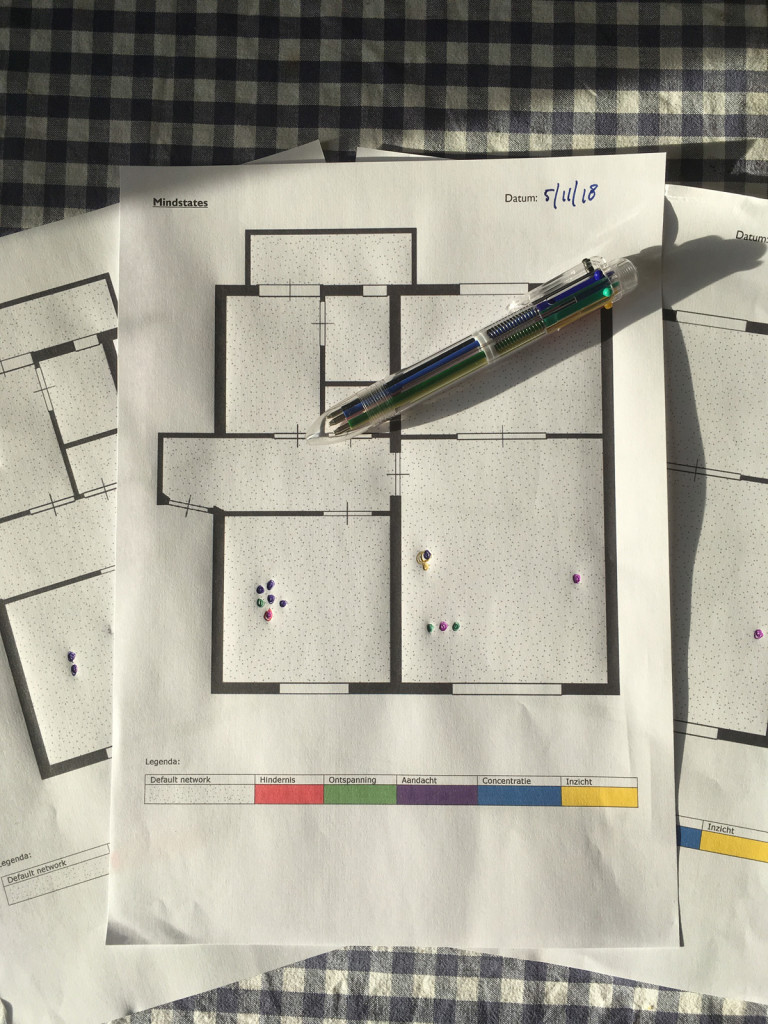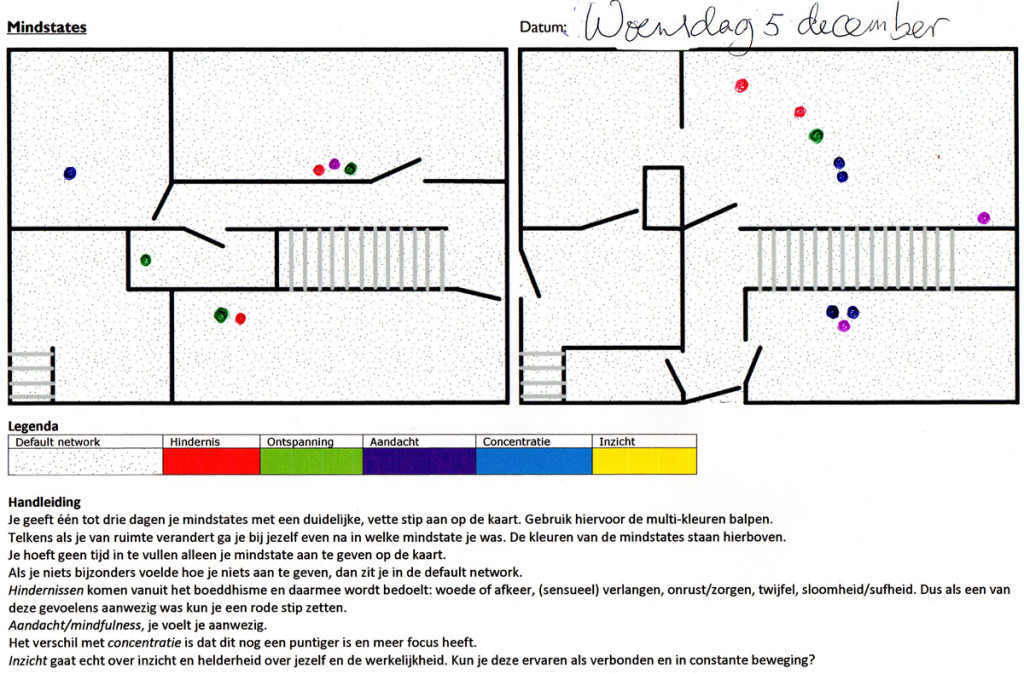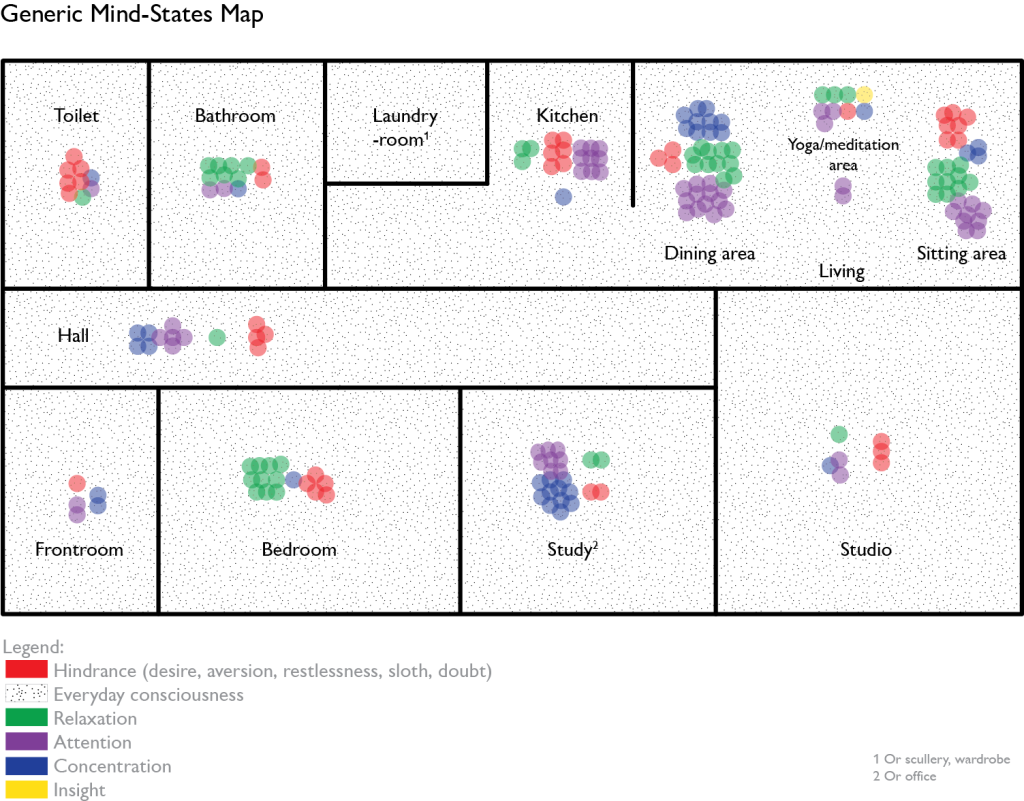This is the first report of the research I am doing towards creating a Wisdom Interface. The goal of this interface is to generate moments of insight during everyday activities. In order for these wisdom interventions to be effective I have to know what would be the best location to stage the interventions. For an intervention to be effective the users’ mind has to be more focused and relaxed than it usually is. Everyday consciousness often is a state of distraction and daydreaming. People sometimes also suffer from hindrances like aversion, anger, sorrow or sleepiness. Both states are not ideal for intervening because the mind isn’t ready for receiving insight. Ideal would be for the user to be at least relaxed and attentive or possibly concentrated.
What I wanted to know
My research question for designing and conducting this research therefore was: What are the different mind-states people experience in the rooms and places in their own home? The possible mind-states besides everyday consciousness were: hindrance, relaxation, attention, concentration and insight. I asked participants to look back and log their state of mind every time they left a room. They could participate for one up to three days.
Tools used
I have used the personal inventory method to collect mind-states and locations in their home. To make mapping easy I first asked the participants to draw a map of their home. From that I created a digital version with empty rooms so the participants had room to mark their states. Participants would print one map for every day they logged their states. The map also included instructions. In a legend I assigned a colour to each mind-state. I supplied every participant with a multi-colour pen so they only needed one tool to log. Logging was done by creating a clear dot on the map in the appropriate colour and at the right location.
Participants and logs
I first did a three day logging myself. I was surprised at the outcomes and also found the logging itself an insightful activity. I then asked five other people to log for one to three days. All are between 30 and 50 years old. Most had experience with meditation or yoga and were interested how logging their mind-states could create more self awareness at home. This was of course not the question but a nice by-product of this method.
It struck me how hard it was to get responses from people. First for collecting the drawings of their homes and then to get the actual logging results. It took me two months before I could generate a combined map.
One person didn’t send in any results. In total I could work with results from five different people, myself included. I had a total of 11 days of data. Two participants logged three days, two logged two days and one logged one day.
Visualising results
I realised that the homes of my participants were very different. So I made an inventory of all the rooms and created a map of generic house to plot all the logging. I used the software program Adobe Illustrator for both creating the map and to map all the mind-states manually. This way I have created a heat map from which it is instantly clear what the prevalent mind-states in the various rooms are.
Conclusions
Some rooms yielded the expected results: there was mostly a relaxed mind state in both the bedroom and the bathroom. Although relaxation is a prerequisite for insight I think that this kind of relaxation is more related to sleepiness and sloth and not a good starting point for an intervention. Users should feel relaxed but not to the point of sleepiness or indifference. The same holds true for the sitting room. Sloughing on the couch is not the same as a deep sense of relaxation. Besides in the sitting area also a lot of hindrances occurred.
Yoga and meditation area’s unsurprisingly do create the right mind-states. So it will be useful to include or create some sort mindfulness activity or setting with the intervention.
Another obvious candidate is the study/office. There is a lot of attention and concentration while being at work there. The challenge will be how to not disturb the flow of working while at the same time taking advantage of the right state of mind.
As stated earlier some results were really surprising. Sitting or standing and interacting with food seems to create a good mix of attention and relaxation. The kitchen and especially the dining area show a rich set of useful mind-states. With the dining area also showing a lot of concentration.
Interesting areas are the toilet and hallway. The loggings on the toilet were also a surprise for me. Personally I feel very neutral about visiting that room. But a couple of different participants had some strong feelings about the toilet, mostly negative. So even though one is sitting or standing quietly for a few minutes I doesn’t seem the right place to intervene.
I find the hallway interesting because it is a place of transition. Coming into the house or going from one room to the next. It is a place to reset you mind. People are also in motion. It actually is a place where different activities interconnect and it is also unstable because of the movement and being in between rooms. These are natural properties of this space that are worth exploring further.
What’s next?
The focus of this research was on locations at home and the mind-states they promote. My next step will be exploring at what time and during which activities useful mind-states emerge. I will be using the experience sampling method to keep track of them.



Leave a comment